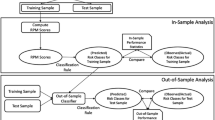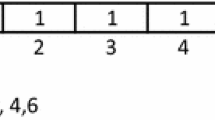Abstract
Credit scoring or predicting bankruptcy is among the most crucial techniques for identifying high-risk and low-risk credit situations. Accordingly, enhancing the accuracy of bankruptcy prediction methods decreases the risk of inappropriate financial decisions. Also, increasing the accuracy of credit scoring models brings significant benefits such as improved turnover, credit market growth, proper and efficient allocation of financial resources, and sustained improvement of the profits of banks, investors, funds, and governments. Various statistical classification methods have been developed in the literature with different features and characteristics for more accurate bankruptcy prediction. However, despite all appearance differences in statistical classification approaches, they all adhere to a common idea and concept in their training procedures. The basic operation logic in whole-developed statistical classification methods focuses on maximizing a continuous distance-based cost function to yield the highest performance. Despite it being a common and frequently used procedure for classification purposes, it is an unreasonable and inefficient manner to achieve maximum accuracy in a discrete classification field. In this paper, a new discrete direction-based Logistic Regression that is a common statistical classifier method for bankruptcy forecasting is proposed. In the proposed Logistic Regression, in contrast to all traditionally developed statistical classifiers, the compatibility of the cost function and the training procedure is considered. While it can be shown overall that the performance of the presented discrete direction-based classifier will not be inferior to its continuous counterpart, an evaluation of the suggested classifier is conducted to ascertain its superiority. For this purpose, three credit scoring datasets are considered to assess the classification rate of the presented classifier. Empirical outcomes demonstrate that, as pre-expected, in all cases, the model put forward can attain a superior performance compared to conventional alternatives. These findings clearly demonstrated the significant influence of the consistency between the cost function and the training process on the classification capability, a consideration absent in any of the traditional statistical classification procedures. Consequently, the presented Logistic Regression can be considered an efficient alternative for credit scoring purposes to achieve more accurate results.

Similar content being viewed by others
Data Availability
Data will be available from the corresponding author upon reasonable request.
References
Kao, L. J., Chiu, C. C., & Chiu, F. Y. (2012). A Bayesian latent variable model with classification and regression tree approach for behavior and credit scoring. Knowledge-Based Systems, 36, 245–252. https://doi.org/10.1016/j.knosys.2012.07.004
Akkoç, S. (2012). An empirical comparison of conventional techniques, neural networks and the three stage hybrid adaptive neuro fuzzy inference system (ANFIS) model for credit scoring analysis: The case of Turkish credit card data. European Journal of Operational Research, 222(1), 168–178. https://doi.org/10.1016/j.ejor.2012.04.009
Brown, I., & Mues, C. (2012). An experimental comparison of classification algorithms for imbalanced credit scoring data sets. Expert Systems with Applications, 39(3), 3446–3453. https://doi.org/10.1016/j.eswa.2011.09.033
Abdou, H. A. (2009). Genetic programming for credit scoring: The case of Egyptian public sector banks. Expert systems with applications, 36(9), 11402–11417. https://doi.org/10.1016/j.eswa.2009.01.076
Silva, D. M., Pereira, G. H., & Magalhães, T. M. (2022). A class of categorization methods for credit scoring models. European Journal of Operational Research, 296(1), 323–331. https://doi.org/10.1016/j.ejor.2021.04.029
Ahelegbey, D. F., Giudici, P., & Hadji-Misheva, B. (2019). Latent factor models for credit scoring in P2P systems. Physica A: Statistical Mechanics and its Applications, 522, 112–121. https://doi.org/10.1016/j.physa.2019.01.130
Filippopoulou, C., Galariotis, E., & Spyrou, S. (2020). An early warning system for predicting systemic banking crises in the Eurozone: A logit regression approach. Journal of Economic Behavior & Organization, 172, 344–363. https://doi.org/10.1016/j.jebo.2019.12.023
Lee, S., & Jun, C. H. (2018). Fast incremental learning of logistic model tree using least angle regression. Expert Systems with Applications, 97, 137–145. https://doi.org/10.1016/j.eswa.2017.12.014
Klieštik, T., Kočišová, K., & Mišanková, M. (2015). Logit and probit model used for prediction of financial health of company. Procedia economics and finance, 23, 850–855. https://doi.org/10.1016/S2212-5671(15)00485-2
Dumitrescu, E., Hue, S., Hurlin, C., & Tokpavi, S. (2022). Machine learning for credit scoring: Improving logistic regression with non-linear decision-tree effects. European Journal of Operational Research. https://doi.org/10.1016/j.ejor.2021.06.053
Villuendas-Rey, Y., Rey-Benguría, C. F., Ferreira-Santiago, Á., Camacho-Nieto, O., & Yáñez-Márquez, C. (2017). The naïve associative classifier (NAC): A novel, simple, transparent, and accurate classification model evaluated on financial data. Neurocomputing, 265, 105–115. https://doi.org/10.1016/j.neucom.2017.03.085
Sohn, S. Y., Kim, D. H., & Yoon, J. H. (2016). Technology credit scoring model with fuzzy logistic regression. Applied Soft Computing, 43, 150–158. https://doi.org/10.1016/j.asoc.2016.02.025
Nikolic, N., Zarkic-Joksimovic, N., Stojanovski, D., & Joksimovic, I. (2013). The application of brute force logistic regression to corporate credit scoring models: Evidence from Serbian financial statements. Expert Systems with Applications, 40(15), 5932–5944. https://doi.org/10.1016/j.eswa.2013.05.022
Vrontos, S. D., Galakis, J., & Vrontos, I. D. (2021). Modeling and predicting US recessions using machine learning techniques. International Journal of Forecasting, 37(2), 647–671. https://doi.org/10.1016/j.ijforecast.2020.08.005
Teply, P., & Polena, M. (2020). Best classification algorithms in peer-to-peer lending. The North American Journal of Economics and Finance, 51, 100904. https://doi.org/10.1016/j.najef.2019.01.001
Moscatelli, M., Parlapiano, F., Narizzano, S., & Viggiano, G. (2020). Corporate default forecasting with machine learning. Expert Systems with Applications, 161, 113567. https://doi.org/10.1016/j.eswa.2020.113567
Wang, Y., Zhang, Y., Lu, Y., & Yu, X. (2020). A comparative assessment of credit risk model based on machine learning—a case study of bank loan data. Procedia Computer Science, 174, 141–149. https://doi.org/10.1016/j.procs.2020.06.069
Barboza, F., Kimura, H., & Altman, E. (2017). Machine learning models and bankruptcy prediction. Expert Systems with Applications, 83, 405–417. https://doi.org/10.1016/j.eswa.2017.04.006
Fitzpatrick, T., & Mues, C. (2016). An empirical comparison of classification algorithms for mortgage default prediction: Evidence from a distressed mortgage market. European Journal of Operational Research, 249(2), 427–439. https://doi.org/10.1016/j.ejor.2015.09.014
Abdou, H. A., Tsafack, M. D. D., Ntim, C. G., & Baker, R. D. (2016). Predicting creditworthiness in retail banking with limited scoring data. Knowledge-Based Systems, 103, 89–103. https://doi.org/10.1016/j.knosys.2016.03.023
Gordini, N. (2014). A genetic algorithm approach for SMEs bankruptcy prediction: Empirical evidence from Italy. Expert systems with applications, 41(14), 6433–6445. https://doi.org/10.1016/j.eswa.2014.04.026
Cubiles-De-La-Vega, M. D., Blanco-Oliver, A., Pino-Mejías, R., & Lara-Rubio, J. (2013). Improving the management of microfinance institutions by using credit scoring models based on statistical learning techniques. Expert systems with applications, 40(17), 6910–6917. https://doi.org/10.1016/j.eswa.2013.06.031
Lin, T. H. (2009). A cross model study of corporate financial distress prediction in Taiwan: Multiple discriminant analysis, logit, probit and neural networks models. Neurocomputing, 72(16–18), 3507–3516. https://doi.org/10.1016/j.neucom.2009.02.018
Etemadi, S., & Khashei, M. (2024). Etemadi regression in chemometrics: Reliability-based procedures for modeling and forecasting. Heliyon, 10(5), e26399. https://doi.org/10.1016/j.heliyon.2024.e26399
Etemadi, S., Khashei, M., & Tamizi, S. (2023). Etemadi reliability-based multi-layer perceptrons for classification and forecasting. Information Sciences, 651, 119716. https://doi.org/10.1016/j.ins.2023.119716
Liu, W., Fan, H., & Xia, M. (2021). Step-wise multi-grained augmented gradient boosting decision trees for credit scoring. Engineering Applications of Artificial Intelligence, 97, 104036. https://doi.org/10.1016/j.engappai.2020.104036
Guo, S., He, H., & Huang, X. (2019). A multi-stage self-adaptive classifier ensemble model with application in credit scoring. IEEE Access, 7, 78549–78559. https://doi.org/10.1109/ACCESS.2019.2922676
Zhang, H., He, H., & Zhang, W. (2018). Classifier selection and clustering with fuzzy assignment in ensemble model for credit scoring. Neurocomputing, 316, 210–221. https://doi.org/10.1016/j.neucom.2018.07.070
Tripathi, D., Edla, D. R., Kuppili, V., Bablani, A., & Dharavath, R. (2018). Credit scoring model based on weighted voting and cluster based feature selection. Procedia computer science, 132, 22–31. https://doi.org/10.1016/j.procs.2018.05.055
Khashei, M., Rezvan, M. T., Hamadani, A. Z., & Bijari, M. (2013). A bi-level neural-based fuzzy classification approach for credit scoring problems. Complexity, 18(6), 46–57. https://doi.org/10.1002/cplx.21458
Ala’raj, M., & Abbod, M. F. (2016). A new hybrid ensemble credit scoring model based on classifiers consensus system approach. Expert Systems with Applications, 64, 36–55. https://doi.org/10.1016/j.eswa.2016.07.017
Tsai, C. F. (2014). Combining cluster analysis with classifier ensembles to predict financial distress. Information Fusion, 16, 46–58.
Tripathi, D., Edla, D. R., Kuppili, V., & Bablani, A. (2020). Evolutionary extreme learning machine with novel activation function for credit scoring. Engineering Applications of Artificial Intelligence, 96, 103980. https://doi.org/10.1016/j.engappai.2020.103980
Zhang, W., Yang, D., Zhang, S., Ablanedo-Rosas, J. H., Wu, X., & Lou, Y. (2021). A novel multi-stage ensemble model with enhanced outlier adaptation for credit scoring. Expert Systems with Applications, 165, 113872. https://doi.org/10.1016/j.eswa.2020.113872
Funding
There is no funding to report.
Author information
Authors and Affiliations
Contributions
All authors have the same contribution to preparing this manuscript.
Corresponding author
Ethics declarations
Conflict of interest
The authors have no conflict of interest.
Ethical Approval
The authors confirm that ethical conduct has been respected.
Additional information
Publisher's Note
Springer Nature remains neutral with regard to jurisdictional claims in published maps and institutional affiliations.
Rights and permissions
Springer Nature or its licensor (e.g. a society or other partner) holds exclusive rights to this article under a publishing agreement with the author(s) or other rightsholder(s); author self-archiving of the accepted manuscript version of this article is solely governed by the terms of such publishing agreement and applicable law.
About this article
Cite this article
Khashei, M., Etemadi, S. & Bakhtiarvand, N. A New Discrete Learning-Based Logistic Regression Classifier for Bankruptcy Prediction. Wireless Pers Commun 134, 1075–1092 (2024). https://doi.org/10.1007/s11277-024-10961-3
Accepted:
Published:
Issue Date:
DOI: https://doi.org/10.1007/s11277-024-10961-3




